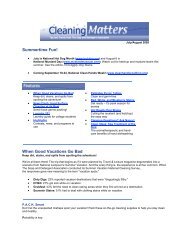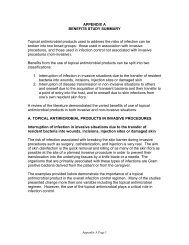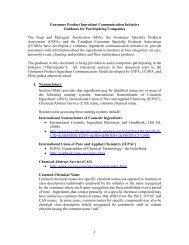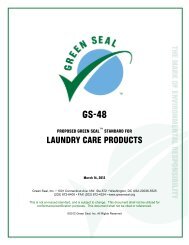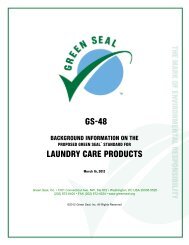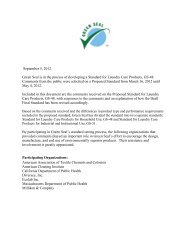subchapter c -- federal hazardous substances act regulations
subchapter c -- federal hazardous substances act regulations
subchapter c -- federal hazardous substances act regulations
Create successful ePaper yourself
Turn your PDF publications into a flip-book with our unique Google optimized e-Paper software.
should be made on the basis of well<br />
conducted, sufficiently validated tests,<br />
preferably as described in OECD Test<br />
Guidelines. Evaluation of the test results<br />
should be done using expert judgement,<br />
weighing all the available evidence. In those<br />
instances where a single well-conducted test is<br />
used, it should provide clear and<br />
unambiguously positive results. If new, well<br />
validated, tests arise these may also be used in<br />
the total weight of evidence to be considered.<br />
The relevance of the route of exposure used in<br />
the study of the substance compared to the<br />
route of human exposure should also be taken<br />
into account.<br />
(e) Other Subjects Related to the<br />
Determination that a Substance is Toxic.<br />
Under the FHSA, for a toxic substance to be<br />
considered <strong>hazardous</strong>, it must not only have<br />
the potential to be <strong>hazardous</strong> but there must<br />
also be the potential that persons are exposed<br />
to the substance, that the substance can enter<br />
the body, and that there is a significant risk of<br />
an adverse health effect associated with the<br />
customary handling and use of the substance.<br />
Under these guidelines, existence of an<br />
adverse health effect means that such exposure<br />
is above the ”acceptable daily intake” (“ADI”).<br />
The ADI is based on the risks posed by the<br />
substance, and whether they are acceptable<br />
under the FHSA. This section addresses those<br />
issues by providing guidelines concerning<br />
assessment of exposure, assessment of<br />
bioavailability, determination of acceptable<br />
risks and the ADI to children and adults, and<br />
assessment of risk.<br />
(1) Assessment of Exposure. An exposure<br />
assessment may comprise a single exposure<br />
scenario or a distribution of exposures.<br />
Reasonably foreseeable use, as well as<br />
accidental exposure, should be taken into<br />
consideration when designing exposure<br />
studies. The following guidelines should be<br />
used in the assessment of exposure.<br />
(i) Inhalation. Inhalation studies to assess<br />
exposure should be reliable studies using<br />
direct monitoring of populations, predictions<br />
of exposure through modeling, or surrogate<br />
data.<br />
(A) Direct Monitoring. Populations to be<br />
monitored should be selected randomly to be<br />
representative of the general population, unless<br />
the exposure of a particular subset population<br />
is the desired goal of the assessment. The<br />
16 CFR Ch. II (1–1–05 Edition)—proposed modificication – 6/25/06<br />
-- 93 --<br />
monitoring technique should be appropriate<br />
for the health effect of interest.<br />
(B) Modeling. Predictions of exposure to a<br />
chemical using mathematical models can be<br />
based on physical and chemical principles,<br />
such as mass balance principles. Mass balance<br />
models should consider the source strength of<br />
the product of interest, housing char<strong>act</strong>eristics,<br />
and ambient conditions likely to be<br />
encountered by the studied population.<br />
(C) Surrogate Data. Surrogate data should<br />
only be used when data concerning the<br />
chemical of interest are sparse or unavailable<br />
and when there is a reasonable assurance that<br />
the surrogate data will accurately represent the<br />
chemical of interest.<br />
(ii) Oral Ingestion. Oral ingestion studies<br />
may involve direct monitoring of sources of<br />
chemicals as well as laboratory simulations.<br />
The estimation of exposure from ingestion of<br />
chemicals present in consumer products is<br />
predicted based upon estimates of use of the<br />
product and absorption of the chemical from<br />
the gastrointestinal tr<strong>act</strong>. The following criteria<br />
should be established for laboratory<br />
simulations to estimate exposure:<br />
(A) A simulant or range of simulants<br />
should be carefully selected to mimic the<br />
possible range of conditions which occur in<br />
humans, such as full and empty stomachs, or<br />
various saliva compositions at different times<br />
of the day.<br />
(B) The mechanical <strong>act</strong>ion to which a<br />
product is submitted must be chosen to<br />
represent some range of realistic conditions to<br />
which a human may subject the product.<br />
(iii) Dermal Exposure. (A) Dermal<br />
exposure involves estimating the amount of<br />
substance cont<strong>act</strong>ing the skin. This may<br />
involve experiments measuring the amount of<br />
material leached from a product cont<strong>act</strong>ing a<br />
liquid layer which interfaces with the skin, or<br />
the amount of substance which migrates from<br />
a product (in solid or liquid form) which is in<br />
cont<strong>act</strong> with the skin.<br />
(B) Parameters to be considered include:<br />
Surface area of the skin cont<strong>act</strong>ed, duration of<br />
cont<strong>act</strong>, frequency of cont<strong>act</strong>, and thickness of<br />
a liquid interfacial layer.<br />
(2) Assessment of Bioavailability. (i) The<br />
need to consider bioavailability in estimating<br />
the risk from use of a product containing a<br />
toxic substance only arises when it is<br />
anticipated that the absorption char<strong>act</strong>eristics



